人教版英语选修六unit1全
- 格式:ppt
- 大小:9.96 MB
- 文档页数:157
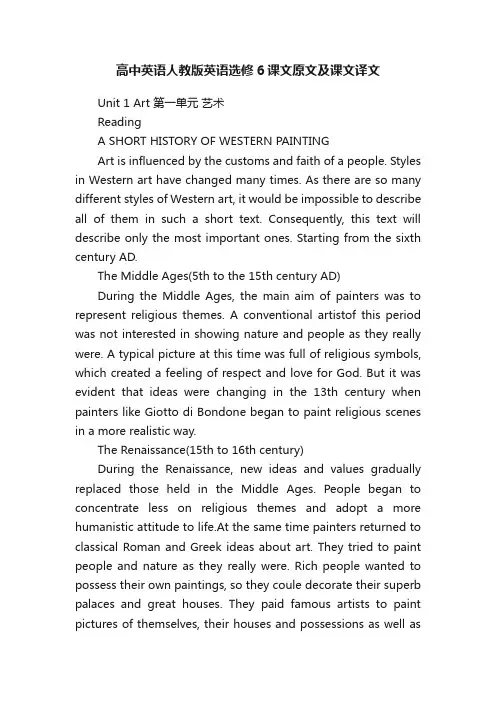
高中英语人教版英语选修6课文原文及课文译文Unit 1 Art 第一单元艺术ReadingA SHORT HISTORY OF WESTERN PAINTINGArt is influenced by the customs and faith of a people. Styles in Western art have changed many times. As there are so many different styles of Western art, it would be impossible to describe all of them in such a short text. Consequently, this text will describe only the most important ones. Starting from the sixth century AD.The Middle Ages(5th to the 15th century AD)During the Middle Ages, the main aim of painters was to represent religious themes. A conventional artistof this period was not interested in showing nature and people as they really were. A typical picture at this time was full of religious symbols, which created a feeling of respect and love for God. But it was evident that ideas were changing in the 13th century when painters like Giotto di Bondone began to paint religious scenes in a more realistic way.The Renaissance(15th to 16th century)During the Renaissance, new ideas and values gradually replaced those held in the Middle Ages. People began to concentrate less on religious themes and adopt a more humanistic attitude to life.At the same time painters returned to classical Roman and Greek ideas about art. They tried to paint people and nature as they really were. Rich people wanted to possess their own paintings, so they coule decorate their superb palaces and great houses. They paid famous artists to paint pictures of themselves, their houses and possessions as well astheir activities and achievements.One of the most important discoveries during this period was how to draw things in perspective. This technique was first used by Masaccio in 1428. When people first saw his paintings, they were convinced that they were looking through a hole in a wall at a real scene. If the rules of perspective had not been discovered, no one would have been able to paint such realistic pictures. By coincidence,oil paints were also developed at this time, which made the colours used in paintings look richer and deeper. Without the new paints and the new technique, we would not be able to see the many great masterpieces for which this period is famous.Impressionism(late 19h to early 20th century)In the late 19th century, Europe changed a great deal,from a mostly agricultural society to a mostly industrial one. Many people moved from the countryside to the new cities. There were many new inventions and social changes also led to new painting styles. Among the painters who broke away from the traditional style of painting were the Impressionists, who lived and worke in Paris.The Impressionists were the first painters to work outdoors. They were eager to show how light and shadow fell on objects at different times of day. However, because natural light changes so quickly, the Impressionists had to paint quickly. Their paintings were not as detailed as those of earlier painters. At first, many people disliked this style of painting and became very angry about it. They said that the painters were careless and their paintings were ridiculous.Modern Art(29th century to today)At the time they were created, the Impressionist paintingswere controversial, but today they are accepeted as the beginning of what we call 'modern art'. This is because the Impressionists encouraged artists to look at their environment in new ways. There are scores of modern art styles,but without the Impressionists, many of these painting styles might not exsist. On the one hand, some modern art is abstract; that is, the painter does not attempt to paint objects as we see them with our eyes, but instead concentrates n certain qualities of the object, using colour, line and shape to represent them. On the other hand, some paintings of modern art are so realistic that they look like photographs. These styles are so different. Who can predict what painting styles there will be in the future?西方绘画艺术简史西方艺术风格变化较大,而中国艺术风格变化较小。
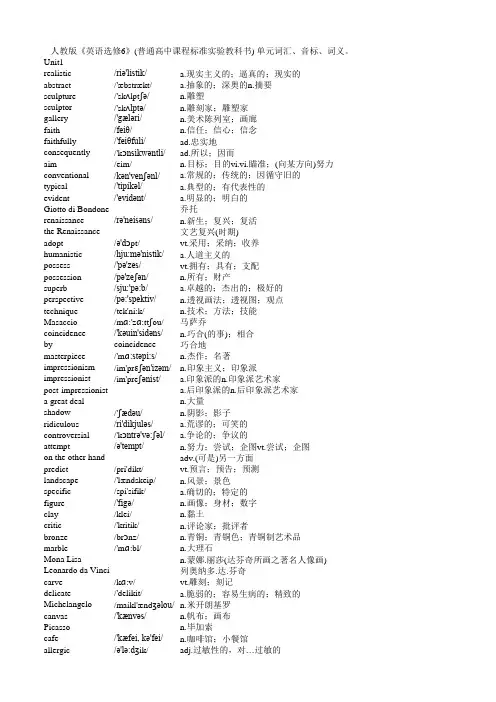
人教版《英语选修6》(普通高中课程标准实验教科书) 单元词汇、音标、词义。
Unit1realistic/riə'listik/ a.现实主义的;逼真的;现实的abstract/'æbstrækt/ a.抽象的;深奥的n.摘要sculpture/'skʌlptʃə/n.雕塑sculptor/'skʌlptə/n.雕刻家;雕塑家gallery/'gæləri/n.美术陈列室;画廊faith/feiθ/n.信任;信心;信念faithfully/'feiθfuli/ad.忠实地consequently/'kɔnsikwəntli/ad.所以;因而aim/eim/n.目标;目的vi.vi.瞄准;(向某方向)努力conventional/kən'venʃənl/ a.常规的;传统的;因循守旧的typical/'tipikəl/ a.典型的;有代表性的evident/'evidənt/ a.明显的;明白的Giotto di Bondone乔托renaissance/rə'neisəns/n.新生;复兴;复活the Renaissance文艺复兴(时期)adopt/ə'dɔpt/vt.采用;采纳;收养humanistic/hju:mə'nistik/ a.人道主义的possess/'pə'zes/vt.拥有;具有;支配possession/pə'zeʃən/n.所有;财产superb/sju:'pə:b/ a.卓越的;杰出的;极好的perspective/pə:'spektiv/n.透视画法;透视图;观点technique/tek'ni:k/n.技术;方法;技能Masaccio/mɑ:'zɑ:ttʃou/马萨乔coincidence/'kəuin'sidəns/n.巧合(的事);相合by coincidence巧合地masterpiece/'mɑ:stəpi:s/n.杰作;名著impressionism/im'prɛʃən'izəm/n.印象主义;印象派impressionist/im'preʃənist/ a.印象派的n.印象派艺术家post-impressionist a.后印象派的n.后印象派艺术家a great deal n.大量shadow/'ʃædəu/n.阴影;影子ridiculous/ri'dikjuləs/ a.荒谬的;可笑的controversial/'kɔntrə'və:ʃəl/ a.争论的;争议的attempt/ə'tempt/n.努力;尝试;企图vt.尝试;企图on the other hand adv.(可是)另一方面predict/pri'dikt/vt.预言;预告;预测landscape/'lændskeip/n.风景;景色specific/spi'sifik/ a.确切的;特定的figure/'figə/n.画像;身材;数字clay/klei/n.黏土critic/'kritik/n.评论家;批评者bronze/brɔnz/n.青铜;青铜色;青铜制艺术品marble/'mɑ:bl/n.大理石Mona Lisa n.蒙娜.丽莎(达芬奇所画之著名人像画) Leonardo da Vinci列奥纳多.达.芬奇carve/kɑ:v/vt.雕刻;刻记delicate/'delikit/ a.脆弱的;容易生病的;精致的Michelangelo/maikl'ændʒəlou/n.米开朗基罗canvas/'kænvəs/n.帆布;画布Picasso n.毕加索cafe/'kæfei, kə'fei/n.咖啡馆;小餐馆allergic/ə'lə:dʒik/adj.过敏性的,对…过敏的effectively/i'fektivli/adv.有效地exhibition/'eksi'biʃən/n.展览;陈列;展览会aggressive/ə'gresiv/ a.敢做敢为的;侵略的;好斗的scholar/'skɔlə/n.学者flesh/fleʃ/n.肉;肌肉;肉体in the flesh adv.活着的;本人Matisse马蒂斯geometry/dʒi'ɔmitri/n.几何学bunch/bʌntʃ/n.束;串Manhattan/mæn'hætn/n.曼哈顿岛;曼哈顿区avenue/'ævinju:/n.林荫道;道路;大街preference/'prefərəns/n.喜爱;偏爱Guggenheim Museum古根海姆博物馆display/dis'plei/vt.展览;陈列;显露appeal/ə'pi:l/vi.有感染力;呼吁;求助vt.将...上诉n.呼吁;appeal to(对某人)有吸引力;(使某人)感兴趣fragile/'frædʒail/ a.精细的;易碎的;脆弱的circular/'sə:kjulə/ a.圆形的;环形的;循环的metropolitan/'metrə'pɔlitən/ a.主要都市的;大城市的reputation/'repju(:)'teiʃən/n.名声;名誉civilization/'sivilai'zeiʃən/n.文明;文化;文明社会Egypt/'i:dʒipt/n.埃及Egyptian/i'dʒipʃən/ a.埃及的,埃及人的visual/'vizjuəl/ a.视觉的;看得见的fragrant/'freigrənt/adj.香的;令人愉快的Monet n.莫奈Whitney/'witni, 'hw-/惠特尼Madison/'mædisn/麦迪逊contemporary/kən'tempərəri/ a.当代的;同时代的permanent/'pə:mənənt/ a.永久的;持久的district/'distrikt/n.区;区域;行政区committee/kə'miti/n.委员会signature/'signitʃə/n.署名;签字Unit2poetry/'pəuitri/n.诗;诗意tick/tik/vt.给...标记号rhyme/raim/n.韵;押韵;押韵的词vi.vt.(使)押韵convey/kən'vei/vt.传达;运送emotion/i'məuʃən/n.情感;情绪;感情nursery/'nə:səri/n.托儿所nursery rhyme童谣concrete/'kɔnkri:t/ a.具体的repetition/'repi'tiʃən/n.重复;反复;循环contradictory/kɔntrə'diktəri/ a.引起矛盾的;好反驳的hush/hʌʃ/v.(使某人)安静下来mockingbird/'mɔkiŋbə:d/n.嘲鸫(一种鸟)diamond/'daiəmənd/n.钻石;菱形brass/brɑ:s/n.黄铜;黄铜器billy-goat n.公山羊flexible/'fleksəbl/ a.灵活的;可弯曲的;柔顺的pattern/'pætən/n.模式;式样;图案squire/'skwaiə/n.乡绅cottage/'kɔtidʒ/n.村舍;小屋coffin/'kɔfin/n.棺材sparrow/'spærəu/n.麻雀kitten/'kitn/n.小猫take it easy轻松;不紧张;从容run out of用完cinquain/siŋ'kein, 'siŋkein/n.五行诗be made up of由...构成tease/ti:z/vt.vi.取笑;招惹;戏弄salty/'sɔ:lti/ a.含盐的;咸的droop/dru:p/v.低垂;凋萎;萎靡dread/dred/vi.vt.害怕;畏惧endless/'endlis/ a.无穷的;无止境的haiku/'haiku:/n.俳句syllable/'siləbl/n.音节minimum/'miniməm/n.最低限度;最少量;最小数translation/træns'leiʃən/n.翻译;译文branch/brɑ:ntʃ/n.枝条;支流;部门melt/melt/vi.融化;溶化;软化brimful/'brim'ful/adj.盈满的;满到边际的in particular尤其;特别eventually/i'ventjuəli/ad.最后;终于await/ə'weit/vt.等候;期待transform/træns'fɔ:m/vt.vi.转化;转换;改造;变换revolve/ri'vɔlv/vi.vt.(使)旋转utter/'ʌtə/vt.说;讲;发出(声音)sorrow/'sɔrəu/n.悲伤;悲痛;懊悔bare/bɛə/ a.赤裸的;光秃的;稀少的n.最基本的要素librarian/lai'brɛəriən/n.图书馆馆长;图书馆管理员forever/fə'revə/ad.永远stem/stem/n.茎;干cement/si'ment/n.水泥section/'sekʃən/n.部门;节;切下的块appropriate/ə'prəupriit/ a.适当的;正当的exchange/iks'tʃeindʒ/n.交换;交流;互换vt.vi.调换;交换diploma/di'pləumə/n.毕业文凭;学位证书sponsor/'spɔnsə/n.赞助人;主办者;倡议者vt.发起;举办;倡blank/blæŋk/n.空白a.空白的;茫然的compass/'kʌmpəs/n.指南针;罗盘;圆规bride/braid/n.新娘bridegroom/'braidgrum/n.新郎championship/'tʃæmpjənʃip/n.冠军称号rhythmic/'riðmik/adj.有节奏的;有规律的darkness/'dɑ:knis/n.黑暗;漆黑warmth/wɔ:mθ/n.暖和;温暖try out测试;试验scholarship/'skɔləʃip/n.奖学金;学问;学术成就pianist/'pjænist/n.钢琴家,钢琴演奏者violinist/vaiə'linist/n.小提琴演奏者let out发出;放走load/ləud/n.负担;负荷物Unit3cigarette n.香烟;纸烟alcohol/'ælkəhɔl/n.酒;酒精alcoholic/'ælkə'hɔlik/adj.酒精的abuse/ə'bju:z, ə'bju:s/n.vt.滥用;虐待fitness n.健康sexual/'seksjuəl/ a.性的;性别的stress/stres/n.压力;重音vt.加压力于;使紧张stressful/'stresfəl/ a.产生压力的;紧张的obesity/ou'bi:siti/n.肥胖;肥胖症adolescent/ædə'lesənt/n.青少年a.青春期的adolescence/'ædəu'lesns/n.青春期ban/bæn/vt.禁止;取缔n.禁令;谴责due/dju:/ a.欠款的;预定的;到期的due to由于...tough/tʌf/ a.困难的;强硬的addicted a.入了迷的,上了瘾的addicted to对...有瘾nicotine/'nikəti:n/n.尼古丁accustom/ə'kʌstəm/vt.使习惯于accustomed/ə'kʌstəmd/ a.惯常的;习惯了的accustomed to习惯于...withdrawal/wið'drɔ:l/n.收回;撤退;戒毒过程bad-tempered a.脾气暴躁的;易怒的automatic/'ɔ:tə'mætik/ a.无意识的;自动的automatically/'ɔ:tə'mætikəli/ad.无意识地;自动地mental/'mentl/ a.精神的;智力的mentally/'mentli/ad.精神上;智力上quit/kwit/vt.停止;离开effect/i'fekt/n.结果;效力lung/lʌŋ/n.肺pregnant/'pregnənt/ a.怀孕的abnormal/æb'nɔ:məl/ a.畸形的;异常的breathless/'breθlis/ a.气喘吁吁的;屏息的unfit/'ʌn'fit/ a.不健康的;不合适的;不合格的strengthen/'streŋθən/vt.加强;巩固;使坚强vi.变强resolve/ri'zɔlv/n.决心;决定decide on对...作出决定packet/'pækit/n.小包;小盒feel like(doing)想要(做)...relaxation/ri:læk'seiʃən/n.放松;松驰desperate/'despərit/ a.绝望的;拼命的chemist/'kemist/n.药剂师;化学家gum/gʌm/n.树胶chewing gum口香糖disappointed/'disə'pɔintid/adj.失望的;沮丧的weaken/'wi:kən/vi.动摇;减弱vt.变弱ashamed/ə'ʃeimd/ a.感到惭愧或羞耻的comprehension/'kɔmpri'henʃən/n.理解(力)in spite of不管;不顾take risks冒险take a risk冒险get into陷入;染上(坏习惯)etc ad.诸如此类的事物;等等appendix/ə'pendiks/n.附录;附件illegal/i'li:gəl/ a.不合法的;违法的pill/pil/n.药丸;药片robbery/'rɔbəri/n.抢劫;盗窃slippery/'slipəri/ a.滑的HIV人体免疫缺损病毒AIDS n.艾滋病at risk处境危险;遭受危险SARS非典型性肺炎immune/i'mjun/ a.有免疫力的survival/sə'vaivəl/n.幸存;幸存者sex/seks/n.性;性别fluid/'flu(:)id/n.流体;液体inject/in'dʒekt/vt.注射injection/in'dʒekʃən/n.注射;注射剂needle/'ni:dl/n.针;针头spill/spil/vi.溢出;洒落vt.使溢出;使洒落male/meil/ a.男性的;雄性的n.男人;雄性动(植)物female/'fi:meil/n.a.女性的;雌性的n.雌性的动(植)物;女人condom/'kɔndəm/n.避孕套homosexual/'houmə'sekʃuəl/n.同性恋a.同性恋的prejudice/'predʒudis/n.偏见;成见judgement/'dʒʌdʒmənt/n.看法;判决;判断disco/'diskou/n.迪斯科舞会;迪斯科舞厅abortion/ə'bɔ:ʃən/n.流产;中途失败cigar/si'gɑ:/n.雪茄烟embarrassed a.尴尬的;陷入困境的awkward/'ɔ:kwəd/ a.局促不安的;笨拙的Unit4consume/kən'sju:m/vt.消耗;消费;耗尽;吃完renewable/ri'njuəbl/adj.能再生的;可更新的greenhouse Fahrenheit/'færənhait/ a.华氏的n.华氏温度计come about发生;造成Sophie/'soufi/n.索菲(女名)Armstrong/'ɑ:mstrɔŋ/阿姆斯特朗graph/græf/n.图表;坐标图;曲线图random/'rændəm/ a.胡乱的;任意的phenomenon/fi'nɔminən/n.现象subscribe/səb'skraib/vi.同意;捐赠;订阅vt.(签署)文件;捐助subscribe to v.同意;赞成;订购fossil/'fɔsl/n.化石;从地下采掘出来的(矿物)fuel/fjuəl/n.燃料byproduct n.副产品Janice/'dʒænes/贾尼丝(女子名)Foster/'fɔstə/福斯特methane/'meθein/n.甲烷;沼气Celsius a.(温度)摄氏的quantity/'kwɔntiti/n.量;数量quantities of大量的tend/tend/vi.趋向;易于;照顾vt.照顾;护理go up上升;增长;升起Charles Keeling查尔斯.基林measurement/'meʒəmənt/n.衡量;测量;尺寸per/pə:/prep.每;每一data/'deitə/n.资料;数据result in导致trend/trend/n.趋势;倾向;走向catastrophe/kə'tæstrəfi/n.大灾难;浩劫flood/flʌd/n.洪水;水灾drought/draut/n.旱灾;干旱famine/'fæmin/n.饥荒George Hambley乔治.汉布利oppose/ə'pəuz/vt.反对;反抗;与(某人)较量opposed/ə'pəuzd/ a.反对的;对立的be opposed to反对...mild/maild/ a.温和的;温柔的;淡的environmental/in'vaiərən'mentl/ a.环境的environmentalist/invairən'mentlist/n.环境保护论者consequence/'kɔnsikwəns/n.结果;后果;影响state/steit/vt.陈述;说明range/reindʒ/n.种类;范围even if即使keep on继续glance/glɑ:ns/vi.看一下;扫视n.一瞥steady/'stedi/ a.平稳的;持续的;稳固的steadily/'stedili/ad.平稳地;持续地tendency/'tendənsi/n.倾向;趋势widespread/'waidspred/ a.分布广的;普遍的on the whole大体上;基本上economical/'i:kə'nɔmikəl/ a.节约的;经济的hectare/'hektɑ:/n.公顷average/'ævəridʒ/ a.平均的existence/ig'zistəns/n.生存;存在outer/'autə/ a.外部的;外面的on behalf of代表…一方;作为…的代言人individual/'indi'vidjuəl/n.个人;个体a.单独的;个别的advocate/'ædvəkit/vt.拥护;提倡;主张commitment/kə'mitmənt/n.承诺;交托;信奉put up with忍受;容忍pollution/pə'lu:ʃən/n.污染;弄脏growth/grəuθ/n.增长;生长electrical/i'lektrikəl/ a.电的;与电有关的appliance/ə'plaiəns/n.用具;工具;器具so long as只要casual/'kæʒjuəl/ a.随便的;漫不经心的;偶然的and so on等等motor/'məutə/n.发动机can/kæn/n.容器;罐头circumstance/'sə:kəmstəns/n.环境;情况microwave/'maikrəweiv/n.微波炉;微波refresh/ri'freʃ/vt.使恢复;使振作educator/'edʒukeitə/n.教育工作者;教育家contribution/'kɔntri'bju:ʃən/n.贡献imperative/im'perətiv/ a.祈使语气;命令heading/'hediŋ/n.标题slogan/'sləugən/n.标语;口号presentation/'prezen'teiʃən/n.显示;演出nuclear/'nju:kliə/ a.核的;核能的;原子核的disagreement/'disə'gri:mənt/n.分歧;不一致Unit5diagram/'daiəgræm/n.图解;图表;示意图volcano/vɔl'keinəu/n.火山volcanic/vɔl'kænik/ a.火山的volcanology/vɔlkə'nɔlədʒi/n.火山学volcanologist/-dʒist/n.火山学家erupt/i'rʌpt/vi.(指火山)爆发;突然发生eruption/i'rʌpʃən/n.火山爆发;(战争等)爆发ash/æʃ/n.灰;灰末crater/'kreitə/n.火山口;弹坑lava/'lɑ:və/n.熔岩;火山岩hurricane/'hʌrikən/n.飓风;风暴questionnaire/kwestʃə'nɛə/n.问卷;调查表alongside/ə'lɔŋ'said/adv.在旁边;沿着边prep.在…旁边;沿着…的equipment/i'kwipmənt/n.设备;装备appoint/ə'pɔint/vt.任命;委派observatory/əb'zə:vətəti/n.观象台;天文台;气象台database n.数据库;资料库Mount Kilauea基拉韦厄火山evaluate/i'væljueit/vt.评估;评价;估计burn to the ground全部焚毁wave/weiv/n.波浪;波涛vi.波动;起伏;挥手molten/'məultən/ a.熔化的;熔融的fountain/'fauntin/vt.vt.泉水般地喷出或涌出n.喷泉;源泉absolute/'æbsəlu:t/ a.绝对的;完全的absolutely/'æbsəlu:tli/ad.绝对地;完全地spaceman/'speismæn/n.宇航员;航天专家suit/sju:t/n.一套外衣;套装vt.适合;使适宜helmet/'helmit/n.头盔boot/bu:t/n.靴子make one's way前往potential/pə'tenʃəl/n.潜在性;可能性;潜能a.可能的;潜在的actual/'æktjuəl/ a.实在的;实际的geology/dʒi'ɔlədʒi/n.地质学Mount Etna埃特纳火山Sicily/'sisili/n.西西里岛(意大利南部)sample/'sɑ:mpl/n.样品;样本candidate/'kændidit/n.候选人;候补者Mount Vesuvius维苏威火山threat/θret/n.恐吓;威胁bungalow/'bʌŋgələu/n.平房;小屋Pompeii/pɔm'peii:/n.庞培(意大利古都)tornado/tɔ:'neidəu/n.龙卷风;旋风typhoon/tai'fu:n/n.台风thunderstorm n.雷暴precious/'preʃəs/ a.贵重的;珍贵的novelist/'nɔvəlist/n.小说家fog/fɔg/n.雾document/'dɔkjumənt/n.文件;证件rainbow/'reinbəu/n.彩虹uncomfortable/ʌn'kʌmfətəbl/ a.不舒服的;不舒适的balcony/'bælkəni/n.阳台unconscious/ʌn'kɔʃəs/ a.失去知觉的;未察觉的shoot/ʃu:t/vt.射中;射伤shot/ʃɔt/n.射击;枪炮声tremble/'trembl/vi.摇晃;摇动;颤抖sweat/swet/n.汗vi.出汗anxious/'æŋkʃəs/ a.忧虑的;不安的anxiety/æŋg'zaiəti/n.担心;焦虑;渴望panic/'pænik/vi.vt.惊慌n.恐慌;惊慌tsunami/tsu'nɑ:mi/n.海啸;地震海啸glance through v.匆匆看一遍Manchu/mæn'tʃu:/ a.满族的n.满人vary from...to...由...到...不等diverse/dai'və:s/ a.多种多样的;不同的diversity/dai'və:siti/n.多种多样;多样性crane/krein/n.鹤;吊车;起重机leopard/'lepəd/n.豹spectacular/spek'tækjulə/ a.引人入胜的;壮观的bathe/beið/vi.洗澡;游泳arouse/ə'rauz/vt.激发;唤醒某人appreciation/ə'pri:ʃi'eiʃən/n.欣赏;感激;感谢peak/pi:k/n.山顶;顶峰persuasion/pə:'sweiʒən/n.信服;说服guarantee/'gærən'ti:/n.保证;担保。
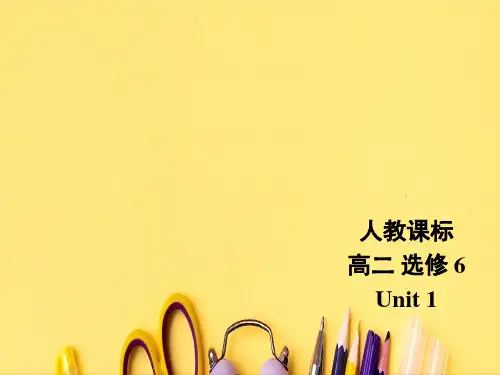
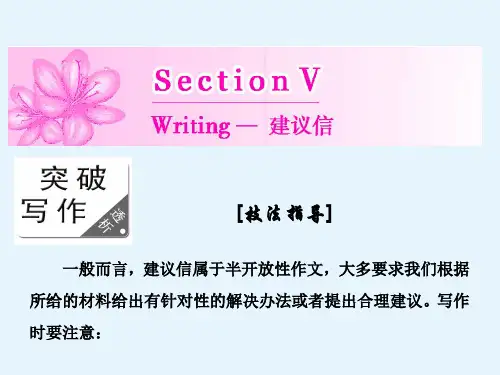
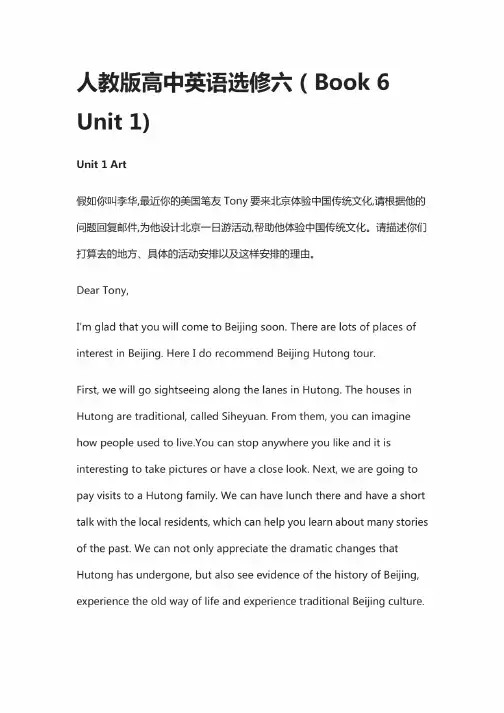
人教版高中英语选修六(Book6 Unit1)Unit1Art假如你叫李华,最近你的美国笔友Tony要来北京体验中国传统文化,请根据他的问题回复邮件,为他设计北京一日游活动,帮助他体验中国传统文化。
请描述你们打算去的地方、具体的活动安排以及这样安排的理由。
Dear Tony,I'm glad that you will come to Beijing soon.There are lots of places of interest in Beijing.Here I do recommend Beijing Hutong tour.First,we will go sightseeing along the lanes in Hutong.The houses in Hutong are traditional,called Siheyuan.From them,you can imagine how people used to live.You can stop anywhere you like and it is interesting to take pictures or have a close look.Next,we are going to pay visits to a Hutong family.We can have lunch there and have a short talk with the local residents,which can help you learn about many stories of the past.We can not only appreciate the dramatic changes that Hutong has undergone,but also see evidence of the history of Beijing, experience the old way of life and experience traditional Beijing culture.In a word,Hutongs are the homes of common people in the past.It is easy to know how people lived and had fun in the old days.So it is a good choice to learn about traditional Chinese culture.I'm looking forward to your coming.Yours,Li Hua1.文章体裁:应用文——电子邮件。
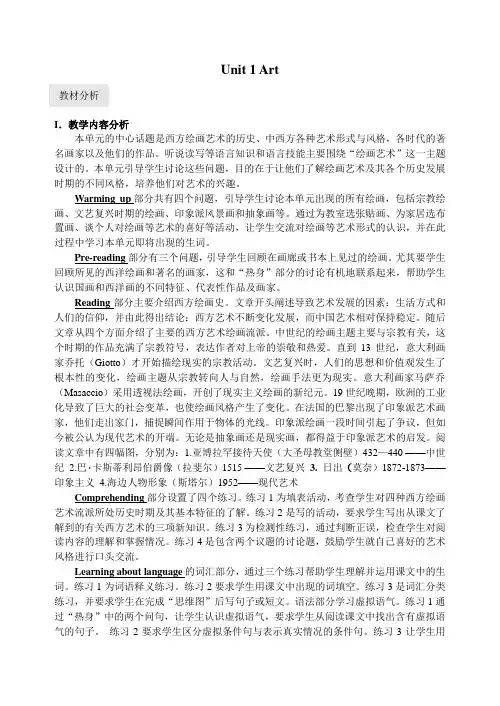
Unit 1 Art教材分析I.教学内容分析本单元的中心话题是西方绘画艺术的历史、中西方各种艺术形式与风格,各时代的著名画家以及他们的作品。
听说读写等语言知识和语言技能主要围绕“绘画艺术”这一主题设计的。
本单元引导学生讨论这些问题,目的在于让他们了解绘画艺术及其各个历史发展时期的不同风格,培养他们对艺术的兴趣。
Warming up部分共有四个问题,引导学生讨论本单元出现的所有绘画,包括宗教绘画、文艺复兴时期的绘画、印象派风景画和抽象画等。
通过为教室选张贴画、为家居选布置画、谈个人对绘画等艺术的喜好等活动,让学生交流对绘画等艺术形式的认识,并在此过程中学习本单元即将出现的生词。
Pre-reading部分有三个问题,引导学生回顾在画廊或书本上见过的绘画。
尤其要学生回顾所见的西洋绘画和著名的画家,这和“热身”部分的讨论有机地联系起来,帮助学生认识国画和西洋画的不同特征、代表性作品及画家。
Reading部分主要介绍西方绘画史。
文章开头阐述导致艺术发展的因素:生活方式和人们的信仰,并由此得出结论:西方艺术不断变化发展,而中国艺术相对保持稳定。
随后文章从四个方面介绍了主要的西方艺术绘画流派。
中世纪的绘画主题主要与宗教有关,这个时期的作品充满了宗教符号,表达作者对上帝的崇敬和热爱。
直到13世纪,意大利画家乔托(Giotto)才开始描绘现实的宗教活动。
文艺复兴时,人们的思想和价值观发生了根本性的变化,绘画主题从宗教转向人与自然,绘画手法更为现实。
意大利画家马萨乔(Masaccio)采用透视法绘画,开创了现实主义绘画的新纪元。
19世纪晚期,欧洲的工业化导致了巨大的社会变革,也使绘画风格产生了变化。
在法国的巴黎出现了印象派艺术画家,他们走出家门,捕捉瞬间作用于物体的光线。
印象派绘画一段时间引起了争议,但如今被公认为现代艺术的开端。
无论是抽象画还是现实画,都得益于印象派艺术的启发。
阅读文章中有四幅图,分别为:1.亚博拉罕接待天使(大圣母教堂侧壁)432—440 ——中世纪 2.巴۰卡斯蒂利昂伯爵像(拉斐尔)1515 ——文艺复兴3. 日出(莫奈)1872-1873——印象主义4.海边人物形象(斯塔尔)1952——现代艺术Comprehending部分设置了四个练习。
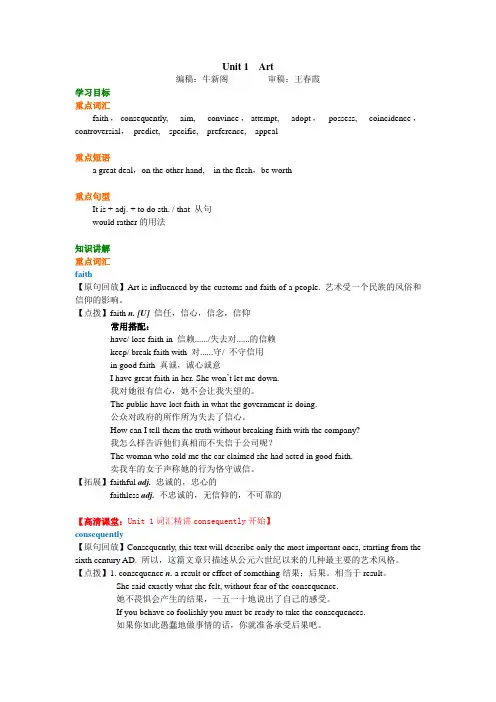
Unit 1 Art编稿:牛新阁审稿:王春霞学习目标重点词汇faith,consequently,aim,convince,attempt, adopt,possess, coincidence,controversial,predict, specific, preference, appeal重点短语a great deal,on the other hand, in the flesh,be worth重点句型It is + adj. + to do sth. / that 从句would rather的用法知识讲解重点词汇faith【原句回放】Art is influenced by the customs and faith of a people. 艺术受一个民族的风俗和信仰的影响。
【点拨】faith n. [U]信任,信心,信念,信仰常用搭配:have/ lose faith in 信赖....../失去对......的信赖keep/ break faith with 对......守/ 不守信用in good faith 真诚,诚心诚意I have great faith in her. She won’t let me down.我对她很有信心,她不会让我失望的。
The public have lost faith in what the government is doing.公众对政府的所作所为失去了信心。
How can I tell them the truth without breaking faith with the company?我怎么样告诉他们真相而不失信于公司呢?The woman who sold me the car claimed she had acted in good faith.卖我车的女子声称她的行为恪守诚信。
【拓展】faithful adj. 忠诚的,忠心的faithless adj.不忠诚的,无信仰的,不可靠的【高清课堂:Unit 1词汇精讲consequently开始】consequently【原句回放】Consequently, this text will describe only the most important ones, starting from the sixth century AD. 所以,这篇文章只描述从公元六世纪以来的几种最主要的艺术风格。
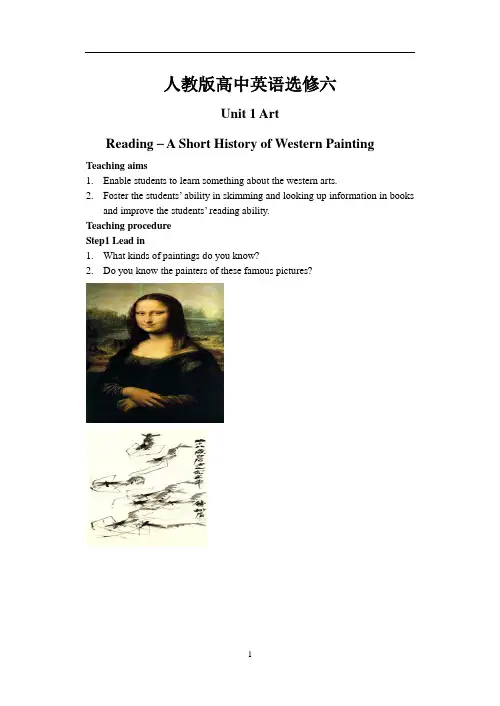
人教版高中英语选修六Unit 1 ArtReading – A Short History of Western PaintingTeaching aims1.Enable students to learn something about the western arts.2.Foster the students’ ability in skimming and looking up information in booksand improve the students’ reading ability.Teaching procedureStep1 Lead in1.What kinds of paintings do you know?2.Do you know the painters of these famous pictures?Step2 Fast reading1. In what order is the passage organized?2. How many western styles are mentioned in the passage and what are they? Step3 Careful readingPara.1:1. What is art influenced?2. Did western art change a lot?The Middle Ages1.What is the aim of painters during the Middle Ages?2. What were the artists not interested in and what were they interested in ? The Renaissance1.In the Renaissance, what did people focus on?2. How did Masaccio paint his paintings?3. What kind of paints were developed at this time?Impressionism1.What happened to Europe in the late 19th century?2. What did the impressionists want to show?3. Why did the impressionists have to paint quickly?4. Why did many people become very angry about the paintings?Modern Art1.What is impressionist paintings accepted as?2.What would have happened if there had been no impressionists?3.What were the qualities of modern art?Step4 Post-reading: True/false questionsStep 5 Writing你的朋友小明最近在学习西方绘画历史方面遇到了难题。
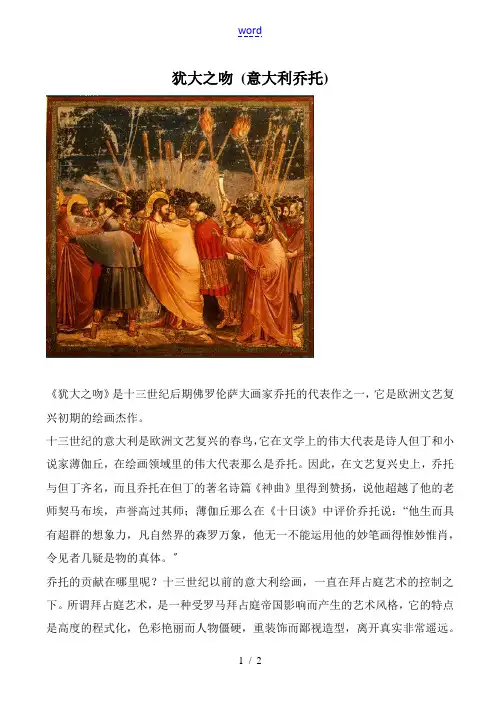
犹大之吻(意大利乔托)《犹大之吻》是十三世纪后期佛罗伦萨大画家乔托的代表作之一,它是欧洲文艺复兴初期的绘画杰作。
十三世纪的意大利是欧洲文艺复兴的春鸟,它在文学上的伟大代表是诗人但丁和小说家薄伽丘,在绘画领域里的伟大代表那么是乔托。
因此,在文艺复兴史上,乔托与但丁齐名,而且乔托在但丁的著名诗篇《神曲》里得到赞扬,说他超越了他的老师契马布埃,声誉高过其师;薄伽丘那么在《十日谈》中评价乔托说:“他生而具有超群的想象力,凡自然界的森罗万象,他无一不能运用他的妙笔画得惟妙惟肖,令见者几疑是物的真体。
〞乔托的贡献在哪里呢?十三世纪以前的意大利绘画,一直在拜占庭艺术的控制之下。
所谓拜占庭艺术,是一种受罗马拜占庭帝国影响而产生的艺术风格,它的特点是高度的程式化,色彩艳丽而人物僵硬,重装饰而鄙视造型,离开真实非常遥远。
特别表现在某某画上,人被“神化〞,而神又被僵化,人物没有个性,形象呆滞僵直。
这种情况从契马布埃(约1240-1320)开始,逐渐有所转变,但是真正使意大利绘画摆脱拜占庭定型式的某某画风的是乔托。
乔托(1266-1337)是佛罗伦萨人,据传说,他是契马布埃的学生。
传说乔托小时候是个牧羊人,在牧羊时以石块和树枝在地上作画,契马布埃偶然在途中见到,惊异于这个牧羊少年画得生动而真实,就收他为学徒了。
后来,他一生从事于为教堂画壁画,从1308年到1334年间,他的壁画遍及罗马、佛罗伦萨、巴图亚、比萨、维罗纳、那不勒斯等地,可惜大都损毁了,保存下来的真迹不多。
最著名的有《犹大之吻》、《逃往埃及》、《基督传》等。
《犹大之吻》是《圣经》故事之一,犹大是出卖耶稣的叛徒。
在逾越节的晚餐桌上,耶稣指出他是出卖主的人。
他知道自己已经暴露,就提前溜走,立即去给敌人引路前来捉拿耶稣,他以亲吻作为暗号。
画面上表现的是犹大带领了一队兵马,还有祭司长和法利赛人的差役,直奔耶稣,要与他亲吻。
画面上耶稣双目盯紧犹大,满眼怒火;犹大那么十分紧X。
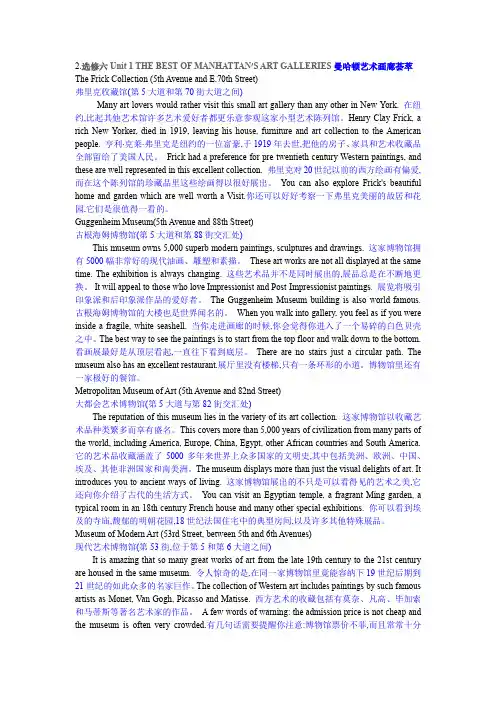
2.选修六Unit 1 THE BEST OF MANHATTAN’S ART GALLERIES曼哈顿艺术画廊荟萃The Frick Collection (5th Avenue and E.70th Street)弗里克收藏馆(第5大道和第70街大道之间)Many art lovers would rather visit this small art gallery than any other in New York. 在纽约,比起其他艺术馆许多艺术爱好者都更乐意参观这家小型艺术陈列馆。
Henry Clay Frick, a rich New Yorker, died in 1919, leaving his house, furniture and art collection to the American people. 亨利·克莱·弗里克是纽约的一位富豪,于1919年去世,把他的房子、家具和艺术收藏品全部留给了美国人民。
Frick had a preference for pre-twentieth century Western paintings, and these are well-represented in this excellent collection. 弗里克对20世纪以前的西方绘画有偏爱,而在这个陈列馆的珍藏品里这些绘画得以很好展出。
You can also explore Frick's beautiful home and garden which are well worth a Visit.你还可以好好考察一下弗里克美丽的故居和花园,它们是很值得一看的。
Guggenheim Museum(5th Avenue and 88th Street)古根海姆博物馆(第5大道和第88街交汇处)This museum owns 5,000 superb modern paintings, sculptures and drawings. 这家博物馆拥有5000幅非常好的现代油画、雕塑和素描。
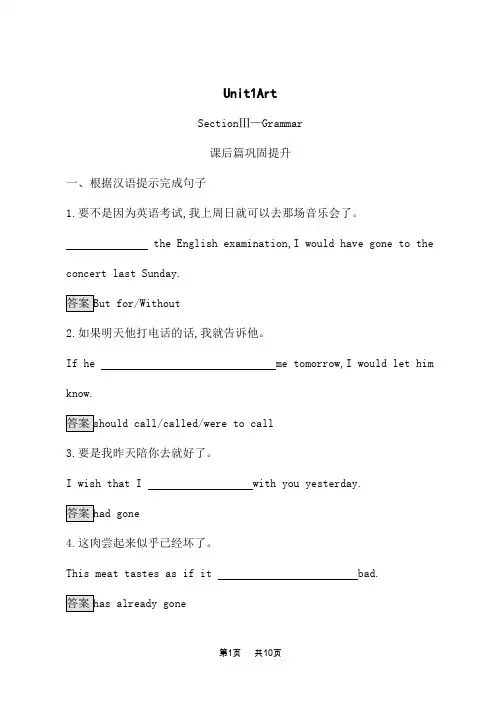
Unit1ArtSectionⅢ—Grammar课后篇巩固提升一、根据汉语提示完成句子1.要不是因为英语考试,我上周日就可以去那场音乐会了。
the English examination,I would have gone to the concert last Sunday.2.如果明天他打电话的话,我就告诉他。
If he me tomorrow,I would let him know.3.要是我昨天陪你去就好了。
I wish that I with you yesterday.4.这肉尝起来似乎已经坏了。
This meat tastes as if it bad.5.如果过去天气好的话,现在庄稼长得就会更好了。
If the weather finer,the cropsstill better.6.她努力工作,仿佛从不知疲倦。
She hard every minute as if she nevertiredness.7.要是早点儿修一下,这辆拖拉机就不会出故障了。
,the tractor would not have broken down.8.如果他们真的能够找到一条通向房间的路,或弄清楚那堵墙后面到底是什么就好了。
If only they a way to get to the room,or whatever it was behind the wall.二、阅读理解OPENINGSANDPREVIEWSAnimalsOutofPaperYolo!Productions and the Great Griffon present the play by Rajiv Joseph,in which an origami(折纸术)artist invites a teenage talent and his teacher into her studio.Merri Milwe directs.In previews.Opens Feb.12.(West Park Presbyterian Church,165 W.86th St.212-868-4444.)TheAudienceHelen Mirren stars in the play by Peter Morgan,about Queen Elizabeth Ⅱ of the UK and her private meetings with twelve Prime Ministers in the course of sixty years.Stephen Daldry directs.Also starring Dylan Baker and Judith Ivey.Previews beginFeb.14.(Schoenfeld,236 W.45th St.212-239-6200.)HamiltonLin-Manuel Miranda wrote this musical about Aleilton,in which the birth of America is presented as an immigrant story.Thomas Kail directs.In previews.Opens Feb.17.(Public,425 LafayetteSt.212-967-7555.)OntheTwentiethCenturyKristin Chenoweth and Peter Gallagher star in the musical comedy by Betty Comden and Adolph Green,about a Broadway producer who tries to win a movie star’s love during a cross-country train journey.Scott Ellis directs,for Roundabout TheatreCompany.Previews begin Feb.12.(American Airlines Theatre,227 W.42nd St.212-719-1300.)1.What is the play by Rajiv Joseph probably about?A.A type of art.B.A teenager’s stud io.C.A great teacher.D.A group of animals.RajivJoseph定位到AnimalsOutofPaper部分,根据本段中的“...inwhichanorigamiartistinvitesateenagetalentandhisteacherin toherstudio.”可知,这部戏剧是关于折纸艺术的。
人教版英语选修6课文原文及课文译文Unit 1 Art 第一单元艺术A SHORT HISTORY OF WESTERN PAINTING 西方绘画艺术简史The style s of Western art had changed many times, while Chinse art had changed less ofen.Art is influenced ['ɪnflʊəns]n. 影响;势力;感化;有影响的人或事vt. 影响;改变by the customs ['kʌstəmz]n. 海关;风俗(custom的复数);习惯;关税and faith [feɪθ+n. 信仰;信念;信任;忠实of a people. Styles [staɪlz]n. 风格;样式;模式(style的复数形式)in Western art have changed many times. As there are so many different style s of Western art, it would be impossible [ɪm'pɒsɪb(ə)l]adj. 不可能的;不可能存在的;难以忍受的;不真实的n. 不可能;不可能的事to describe all of them in such a short text [tekst]n. [计] 文本;课文;主题vt. 发短信. Consequently ['kɒnsɪkw(ə)ntlɪ]adv. 因此;结果;所以, this text will describe only the most important ones. Starting from the sixth century AD.chine [tʃaɪn] n. 脊骨;脊柱chinse [tʃins] n. 填隙;捻缝Chinese [,tʃai'ni:z] n. 中文,汉语;中国人adj. 中国的,中国人的;中国话的西方艺术风格变化较大而中国艺术风格变化较小。
Unit 1 ArtPeriod1 Vocabulary and Useful ExpressionsTeaching Goals:1.To enable Ss to master some new words and expressions2.To get Ss to have knowledge of this grammar point: the subjective moodTeaching Procedures:Step 1. Free talkIf you have a special chance to become a poet, what kind of poems will you write to people?And why?Step 2. Word studyPurpose: To consolidate the words and phrases in the text.1.Find a word in the poems that rhymes with each of the words below. Then add other words that rhyme. The first one has been done for you.(1)dead lead red thread fed said bed(2)high(3)sing(4)today(5)lace(6)trueSuggested Answers:(2)high sky pie my fly shy lie(3)sing ring wing thing king fling string(4)today away say play lay tray may(5)lace race face case chase place space(6)true too new flew few shoe canoeplete the passage using the words below in the correct form.c o t t a g e r u n o u t o f n u r s e r y r h y t h m r e c i t e r h y m eWhen I was a baby, my mother used to read me rhymes, I loved their and the way the words at the end of the lines. By the time I was two years old, I could at least ten of them. When we new nursery rhymes, my mother would go to the store to buy another nursery rhyme book. In fact, my family loved reading so much that the living room in our was full of books.Suggested Answers:nursery; rhythm; rhyme; recite; run out of; cottage.3.In English we sometimes add –ful to a noun to make an adjective. For example, wonder becomes wonderful. This means full of wonder. Now make adjectives form these nouns. Then add four other pairs you know.(1)beauty (5) dread (9)(2)joy (6) hope (10)(3)sorrow (7) peace (11)(4)delight (8) power (12).Suggested Answers:(1) beautiful (2) joyful (3) sorrowful (4) delightful (5) dreadful(6) hopeful (7) peaceful (8) powerful (9) thankful (10) successful (11) painful (12) usefulplete the table with the correct nouns, verbs, adjectives or adverbs.Verb AdverbNoun AdjectiveangrydarkenimpressiverepetitivetransformationaltranslationwarmenjoyexpressivelyinspireSuggested Answers:Verb AdverbNoun Adjectiveanger anger angry Angrilydark darken dark darklyimpression impress impressive impressively repetition repeat repetitive repetitively transformation transform transformational \translation translate translated \warmth warm warm wrmlyenjoyment enjoy enjoyable enjoyably expression express expressive expressively inspiration inspire inspirational inspirationallyplete each sentence using the correct word from the table you have just completed. (1)While you were reciting the poem, I think you moved your body very . It made the performance much more interesting.(2)Ad I lay in the , the words of a new poem came into my head.(3)The teacher doesn’t think that the of the Tang poem is very good.(4)Songs are often easy to remember because they a lot of poetry.(5)Your talk was so that I want to go and write lots of poetry.(6)I loved the strong images you used in your poem to convey feelings of .(7)We were very by the students’ performance of their poetry.(8)We passed the afternoon very reading poetry together under the trees.(9)Mr. Tanne r’s love of poetry has the students’ feelings towards the subject.(10)Even though it is cold, your poem about summer has made me feel really . Answers:(1) expressively (2) darkness (3) translation (4) repeat (5) inspirational (6) anger (7) impressed (8) enjoyably (9) transformed (10) warm Step 3. Grammar1.PresentationPurpose: To revise the usage of the subjunctive mood with Ss.所述情况从句主句与现在事实相反If+主语+动词过去式主语+ would/could/might/should+ (be 动词用were)动词原形与过去事实相反If+主语+动词过去完成式主语+ would/could/might/should+have + 过去分词与将来事实相反①if+主语+动词过去式主语+ would/could/might/should+②if+主语+were to + 动词原形动词原形③if+主语+should+动词原形此表中需要注意几点:(1) be 动词在表示与现在事实相反的从句中一般用were.在非正式情况先,第一、第三人称后偶尔也用was. 如:If he were you, he would go at once.(2) 主句中的should 通常用于第一人称,would,could 以及might 可以用于各种人称。